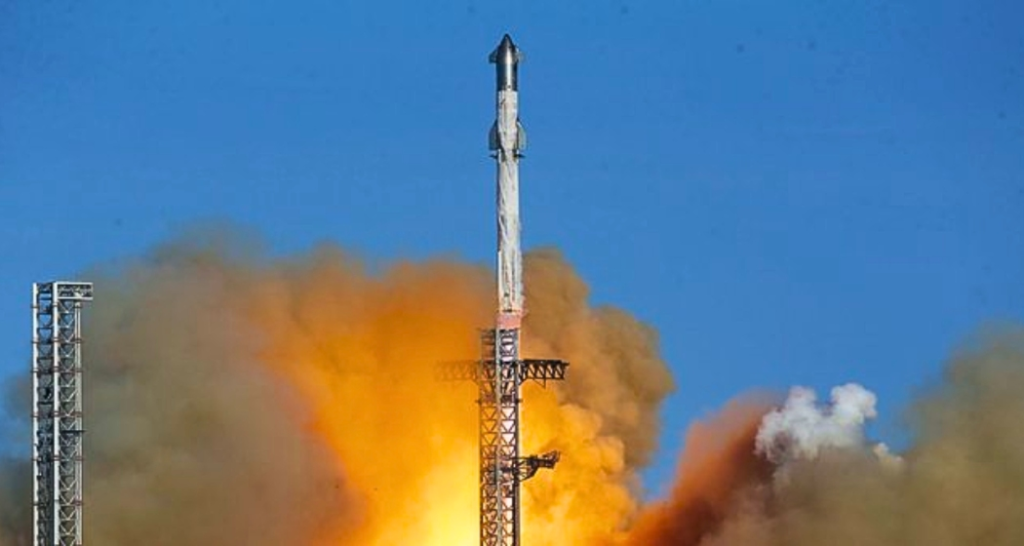In a significant blow to SpaceX’s ambitious plans for future space missions, the upper stage of a Starship test rocket exploded during a static fire engine test at the company’s Starbase facility in Boca Chica, Texas. The incident occurred during a pre-launch procedure, underscoring the ongoing challenges faced by Elon Musk’s private space company in developing the world’s most powerful launch vehicle.
This recent explosion is the latest in a series of technical hurdles for the Starship program, which aims to eventually carry humans to the Moon, Mars, and beyond. While no injuries have been reported, the damage adds delays to already complex timelines for upcoming launches.
What Happened at Starbase, Texas?
According to SpaceX engineers and local eyewitnesses, the explosion occurred as the upper stage of the Starship vehicle was undergoing a static fire test—a routine but high-risk part of the launch preparation process where engines are briefly ignited while the rocket remains on the ground. During the test, an unexpected fireball erupted, followed by a loud blast, sending smoke and debris into the air.

While the full cause is still under investigation, early reports suggest that the explosion happened due to a malfunction in the Raptor engines’ fueling or ignition system. SpaceX has not yet released a detailed official statement, though Elon Musk did acknowledge the event on X (formerly Twitter), referring to it as a “test anomaly.”
The Significance of the Starship Program
Starship is SpaceX’s next-generation, fully reusable rocket system designed to replace the Falcon 9 and Falcon Heavy rockets. Once operational, it will be the tallest and most powerful rocket ever built, capable of carrying more than 100 metric tons into orbit.
The system consists of two main stages: the Super Heavy booster, which provides initial thrust, and the Starship upper stage, which handles payload delivery and space travel. Both stages are designed to return to Earth and be reused.
Starship has been selected by NASA as the lander vehicle for its Artemis III mission, which aims to return humans to the Moon as early as 2026. Any major delays or failures in testing can directly impact this timeline and other future missions.
Not the First Explosion—But Still a Setback
SpaceX is no stranger to explosive testing. Over the years, the company has adopted a “fail fast, learn faster” approach, regularly pushing prototypes to their limits to identify weaknesses. However, with the Starship program now under increasing government and commercial pressure, every failure carries more weight.
This explosion marks another chapter in a series of failed or partially successful test flights and static fire attempts. While such incidents are part of SpaceX’s developmental strategy, repeated failures at this stage could raise questions among regulators, investors, and international partners.
Reactions from Experts and the Public
Aerospace analysts noted that while the explosion is a setback, it is not entirely unexpected given the ambitious scale and technical complexity of Starship.
“Static fires are some of the most stressful moments for rocket systems, especially with such high-thrust engines like the Raptor. This kind of incident, though unfortunate, is part of iterative testing,” said Dr. Laura Kingsley, an aerospace systems engineer at MIT.
Public reaction on social media was mixed. Space fans expressed disappointment but remained hopeful about the program’s future. Critics, however, pointed to environmental risks and potential regulatory concerns surrounding ongoing tests at the Starbase facility.

Environmental groups have already raised concerns about testing near sensitive ecosystems in South Texas, an issue being monitored closely by the Federal Aviation Administration (FAA), which regulates spaceflight activities in the U.S.
What’s Next for SpaceX?
Following standard protocol, SpaceX will now conduct a detailed failure analysis using video, telemetry data, and engine diagnostics. Engineers will work to identify the root cause and implement design changes as needed.
This explosion is likely to delay the next integrated flight test of Starship, which had been tentatively scheduled for late summer. SpaceX must also ensure compliance with FAA regulations before any further tests can be conducted at Starbase.
Meanwhile, the company is pushing forward with other major projects, including satellite launches for the Starlink internet constellation and cargo missions using its Falcon 9 rocket. But the ultimate goal remains full orbital success for Starship, a milestone SpaceX has yet to achieve.
The Road to Mars Just Got Tougher
Elon Musk’s long-term vision includes making humanity a multi-planetary species. Starship is central to this dream. Its ability to launch heavy payloads at a lower cost and return safely is seen as a game-changer for both government space programs and private exploration.
But as this latest explosion shows, the road to Mars is paved with fiery setbacks. Developing the technology to handle deep-space travel is no small feat, and even the most advanced teams will face moments of failure.
With the world watching closely, SpaceX must now prove that its philosophy of rapid development and high-risk testing will lead to reliable systems—and not repeated disasters.
Also Read – Chevrolet Corvette 2025–2026 Lineup Gets Turbo, Hybrid, Screens Upgrade






